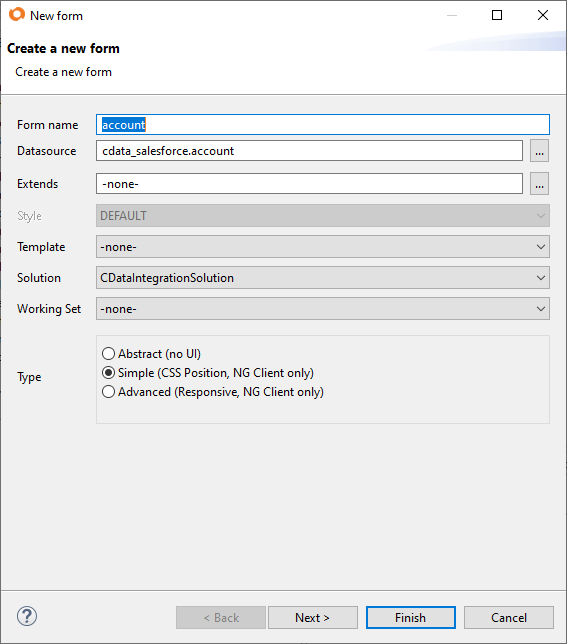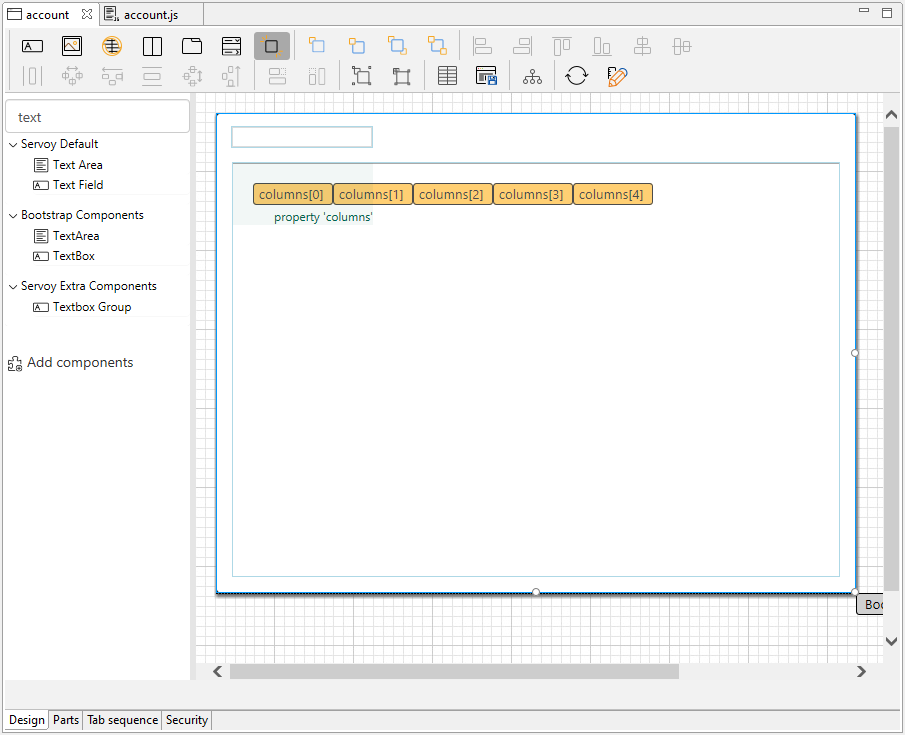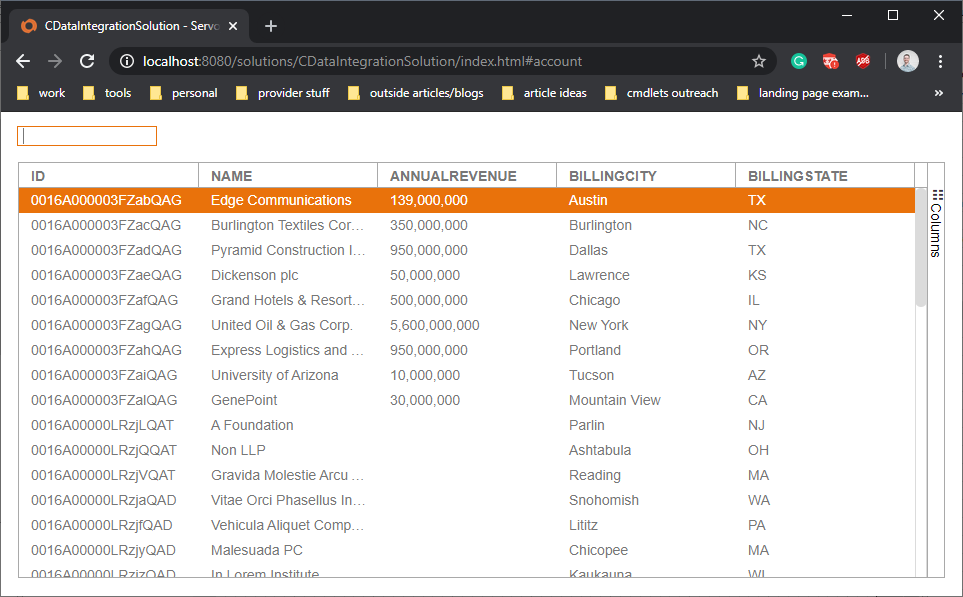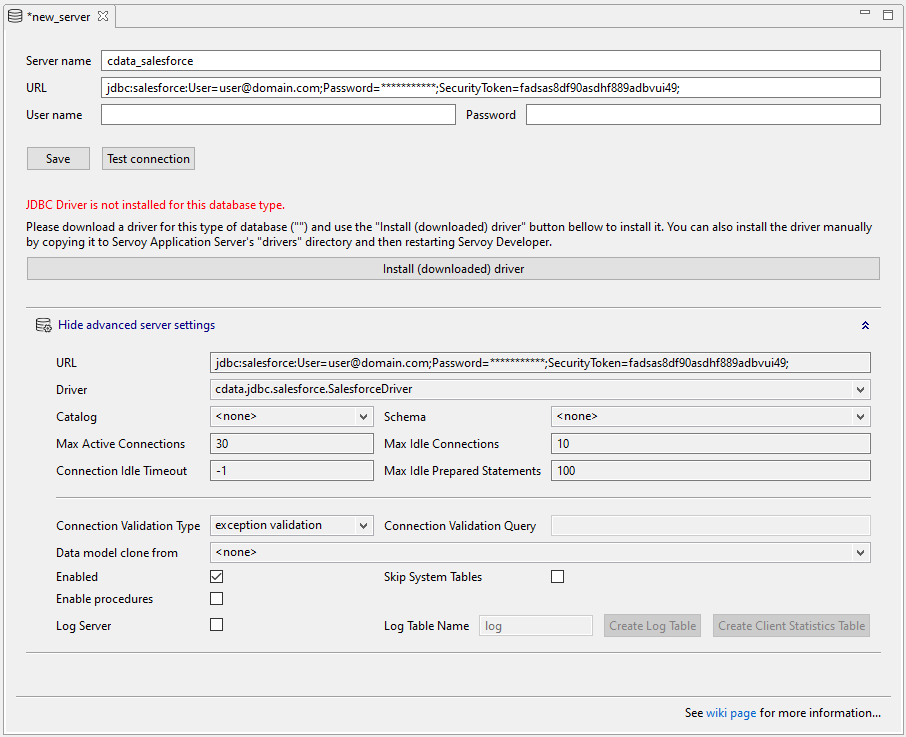Discover how a bimodal integration strategy can address the major data management challenges facing your organization today.
Get the Report →Build Google Sheets-Connected Web Apps in Servoy
Use Servoy Developer to easily connect to Google Sheets data and build web apps with connectivity to live Google Sheets data.
Servoy is a rapid application development and deployment platform. When paired with the CData JDBC Driver for Google Spreadsheets, users can build Google Sheets-connected apps that work with live Google Sheets data. This article describes how to connect to Google Sheets from Servoy and build a simple web app to display and search Google Sheets data.
With built-in optimized data processing, the CData JDBC Driver offers unmatched performance for interacting with live Google Sheets data. When you issue complex SQL queries to Google Sheets, the driver pushes supported SQL operations, like filters and aggregations, directly to Google Sheets and utilizes the embedded SQL engine to process unsupported operations client-side (often SQL functions and JOIN operations). Its built-in dynamic metadata querying lets you work with Google Sheets data using native data types.
Connect to Google Sheets in Servoy Developer
To build Google Sheets-connected apps, you need to first create a data provider in Servoy Developer using the CData JDBC Driver for Google Spreadsheets.
- Install the JDBC Driver.
- Copy the JDBC Driver JAR file. (cdata.jdbc.googlesheets.jar) to the /application_server/drivers/ directory in the installation directory for Servoy.
- Open Servoy Developer.
- In the Solution Explorer, right-click Database Server (under Resources) and choose "Connect to existing database" -> "empty."
- Name the server.
- Click to show the advanced server settings.
Set the URL, for example: jdbc:googlesheets:Spreadsheet=MySheet;InitiateOAuth=GETANDREFRESH
Built-In Connection String Designer
For assistance in constructing the JDBC URL, use the connection string designer built into the Google Sheets JDBC Driver. Either double-click the JAR file or execute the jar file from the command-line.
java -jar cdata.jdbc.googlesheets.jarFill in the connection properties and copy the connection string to the clipboard.
You can connect to a spreadsheet by providing authentication to Google and then setting the Spreadsheet connection property to the name or feed link of the spreadsheet. If you want to view a list of information about the spreadsheets in your Google Drive, execute a query to the Spreadsheets view after you authenticate.
ClientLogin (username/password authentication) has been officially deprecated since April 20, 2012 and is now no longer available. Instead, use the OAuth 2.0 authentication standard. To access Google APIs on behalf on individual users, you can use the embedded credentials or you can register your own OAuth app.
OAuth also enables you to use a service account to connect on behalf of users in a Google Apps domain. To authenticate with a service account, you will need to register an application to obtain the OAuth JWT values.
See the Getting Started chapter in the help documentation to connect to Google Sheets from different types of accounts: Google accounts, Google Apps accounts, and accounts using two-step verification.
![Using the built-in connection string designer to generate a JDBC URL (Salesforce is shown.)]()
- Select the Driver class you just copied, for example, cdata.jdbc.googlesheets.GoogleSheetsDriver
![Connecting to data through the JDBC Driver (Salesforce is shown).]()
Build a Google Sheets-Connected Web App
Once you have configured the connection to Google Sheets in the Servoy Developer resources, you are ready to build apps with access to live Google Sheets data.
Create a New Solution
- In the Server Explorer, right-click "All solutions" and select "Create new solution."
- Name the solution.
- Select the checkbox to include the "search" module.
- Click "Finish."
Create a New Form
Right-click "Forms" and select "Create new form."
- Name the form.
- Select a Datasource.
- Set the type (e.g., Simple) and click "Finish."

Add a Data Grid to the Form
- Drag a Data Grid component (from Servoy NG-Grids) onto the form.
Drag a column component onto the Data Grid and set the "dataprovider" property for each column component to a column from the Google Sheets "table" (e.g., Shipcountry from the Orders table).
Continue adding columns as desired.
Add Searching to the App
Note that the "svySearch" extension is required to add search functionality (included by default when you create a new solution). If you did not add the extension when you created the solution or you are modifying an existing solution, you can add the search module by right-clicking Modules (in the solution) and selecting "Add Module." Select "svySearch" and click "OK."
- Drag a Text Field component onto the Form.
- Right-click the Form and select "Open in Script Editor."
- Create a new variable (JavaScript) to hold the search value:
var searchText = '';
- Back on the Form, in the Text Field properties:
- Set the "dataprovider" property to the Form variable you just created.
- Double-click to add a method for the onAction event.
- Click to create the method in "Form," name the method (e.g., onEnter), and click "Create private."
- Click "OK & Show."
- Add the following JavaScript to the JavaScript file to use the Servoy framework to implement searching bound data based on the text in the Text Field:
var search = scopes.svySearch.createSimpleSearch(foundset).setSearchText(searchText); search.setSearchAllColumns(); search.loadRecords(foundset);

Save and Launch the App
Save the form and JavaScript file, then click Run -> Launch NGClient to start the web app.

Download a free, 30-day trial of the CData JDBC Driver for Google Spreadsheets and start building Google Sheets-connected apps with Servoy. Reach out to our Support Team if you have any questions.








